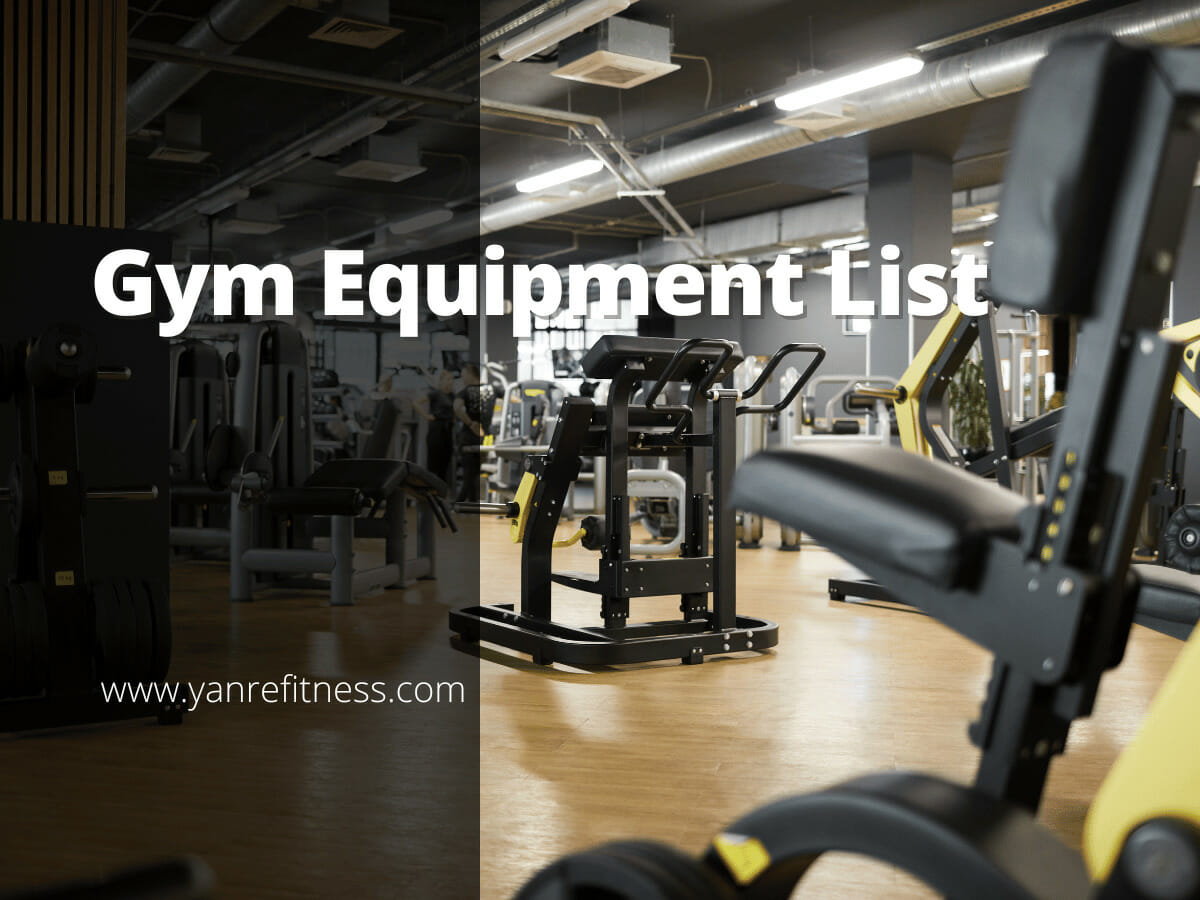Do you ever find yourself wondering about the ideal selection of gym equipment that would meet every customer’s fitness needs? Imagine the satisfaction of stepping into a fitness center that has been perfectly outfitted to provide comprehensive workout options for all. However, with a variety of machines and accessories available on the market, identifying the essential equipment can indeed be an overwhelming task.
Worry no more! In this blog post, we’re committed to solving this conundrum by providing you with a meticulously curated list and type of gym equipment. This guide, replete with names, pictures, prices, and catalog references, is your ultimate resource to establish a well-rounded, efficient gym setup.
Certainly, this comprehensive guide will provide you with gym equipment names and pictures in a PDF format, making it easier for you to identify and select the equipment that best suits your gym’s needs. Let’s dive into the details of various gym equipment options to help you make informed decisions.
So, without further ado, let’s dive into the commercial gym equipment list!
Table of Contents
1. Cardiovascular Equipment
Certainly, understanding the names and uses of different gym equipment is crucial for a well-rounded workout routine. To help you with this, we’ve prepared a comprehensive PDF guide that includes images, names, and uses of various gym equipment. This resource will be invaluable as you navigate the world of fitness and make informed decisions about your exercise routine. Let’s delve deeper into the details of these gym equipment options.
The following list discusses gym equipment essential for cardiovascular workouts, shedding light on each machine:
Treadmill
Of course, understanding gym equipment is essential, and it’s equally important to know the cost considerations. To assist you further, we’ve created a PDF gym equipment price list that provides details on the costs of various fitness machines and accessories. This will be a valuable resource to help you plan your fitness equipment purchases effectively. Now, let’s delve into the details of specific gym equipment, starting with the treadmill.
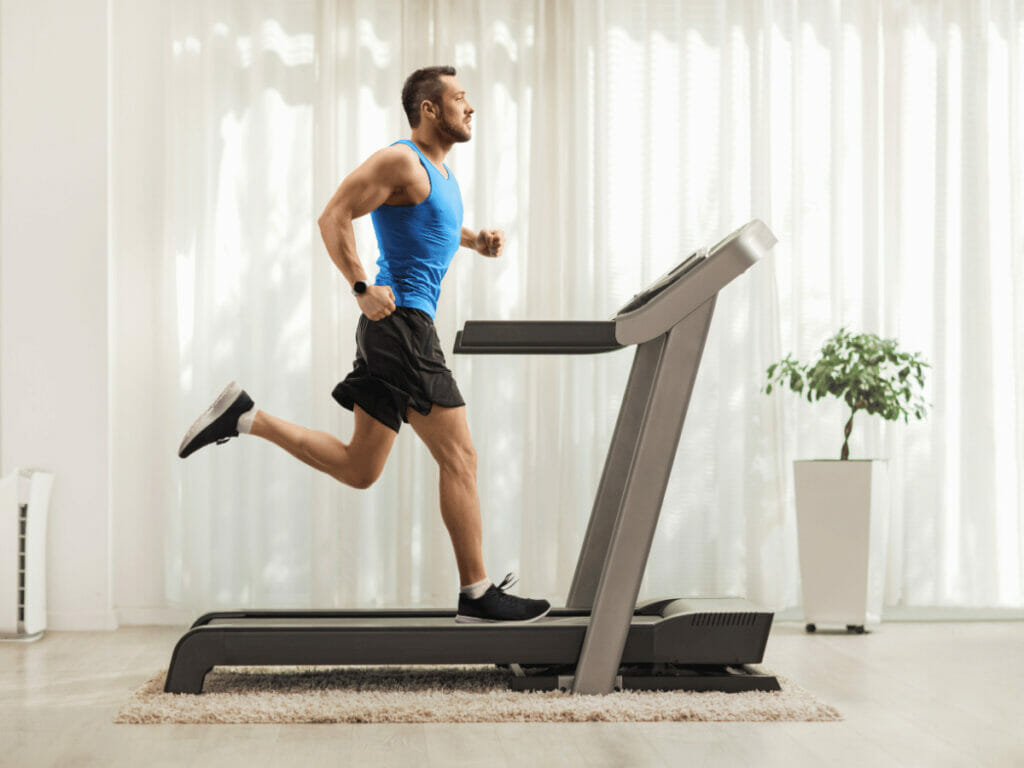
- What Areas/Muscles Does a Treadmill Work: A treadmill primarily targets the lower body, engaging muscles such as the glutes, hamstrings, quadriceps, and calves. Additionally, it also works the core and arm muscles.
- Treadmill Cost: The price range for treadmills is usually between $500 to $3000.
Advantages:
- Versatility: Treadmills are adaptable to various fitness levels and goals, allowing for speed and incline adjustments.
- Cardiovascular Benefits: Regular usage of treadmills can lead to improved heart health and increased stamina. From personal experience, a treadmill never fails to deliver a challenging and effective workout.
Stationary Bike
A stationary bike is an exercise machine that simulates the physical exertions of riding a bicycle. This cardio equipment is typically adjustable and comes with various resistance levels.
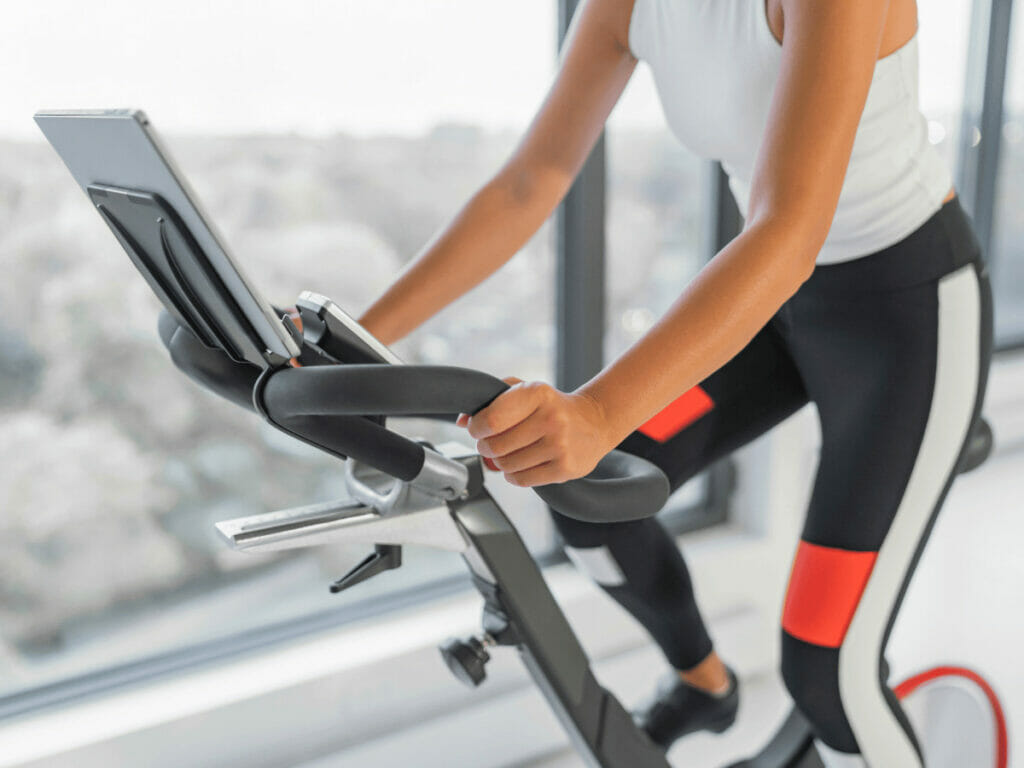
- What Areas/Muscles Does a Stationary Bike Work: Primarily, a stationary bike targets the lower body muscles, including the glutes, quadriceps, hamstrings, and calves. The core is also engaged for stability.
- Stationary Bike Cost: The price of a stationary bike can range from $200 to $2000.
Advantages:
- Low-Impact: A stationary bike offers a low-impact workout that is gentle on the joints, making it suitable for individuals with joint issues.
- Cardiovascular endurance: Regular use can boost cardiovascular health and endurance.
Elliptical Machines
Certainly, it’s crucial to understand gym machine names and their functions, especially when planning your gym setup. To make this process more comprehensive, we’ve prepared a PDF document with images and descriptions of various gym machines. This resource will help you identify the right equipment for your fitness center. Now, let’s continue with the explanation of elliptical machines.
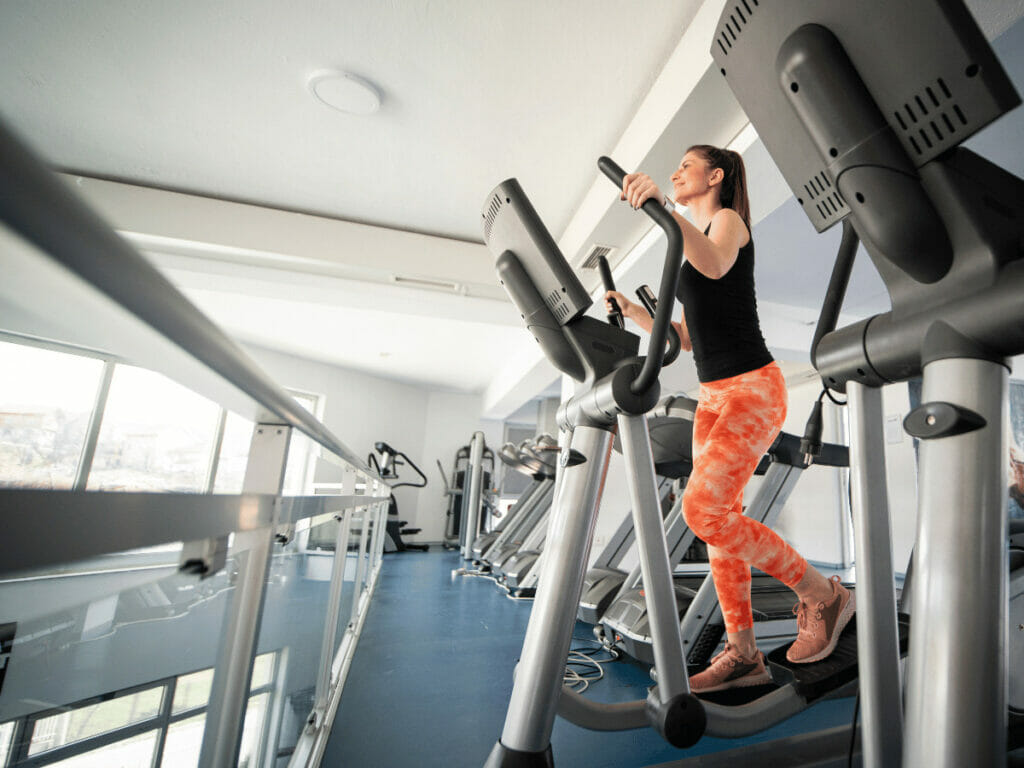
- What Areas/Muscles Does an Elliptical Machine Work: It works both the upper and lower body, targeting the glutes, quadriceps, hamstrings, calves, biceps, triceps, and the core.
- Elliptical Machine Cost: The price for elliptical machines typically falls between $300 and $3000.
Advantages:
- Total-body workout: It offers a comprehensive workout engaging both upper and lower body, thereby maximizing the use of workout time. Yanre Fitness understand the importance of efficiency in workouts, and our top-quality elliptical machines are designed with this in mind that would best fit in any corner of the gym.
- Cardio and strength: It provides cardiovascular benefits while simultaneously offering resistance training for muscle strength. The elliptical machine provides an all-encompassing workout that efficiently uses time, making it a favorite in the gym.
Rowing Machine
Rowing machines are an indoor simulation of outdoor rowing, working your full body in the process. The special thing about these machines, unlike different types of leg press machines, is that they involve both your arms and legs almost equally during use.
- What Areas/Muscles Does an Elliptical Machine Work: A Rowing Machine works a wide array of muscles, including leg muscles like the quadriceps and hamstrings, core muscles like the abdominals and obliques, and upper body muscles such as the back (latissimus dorsi), arms (biceps and triceps), and shoulders (deltoids).
- Rowing Machine Cost: Rowing machine costs may vary from $200 to $2000
Advantages:
- Full Body Workout: The Rowing Machine provides a comprehensive workout, engaging both upper and lower body muscle groups and the core, offering a balanced and effective workout.
- Cardiovascular Fitness: It’s a great cardiovascular exercise, helping to increase heart rate and lung capacity, and can be adjusted to suit various fitness levels.
Stair Climber
This machine replicates the action of climbing stairs, providing an intense cardiovascular workout.
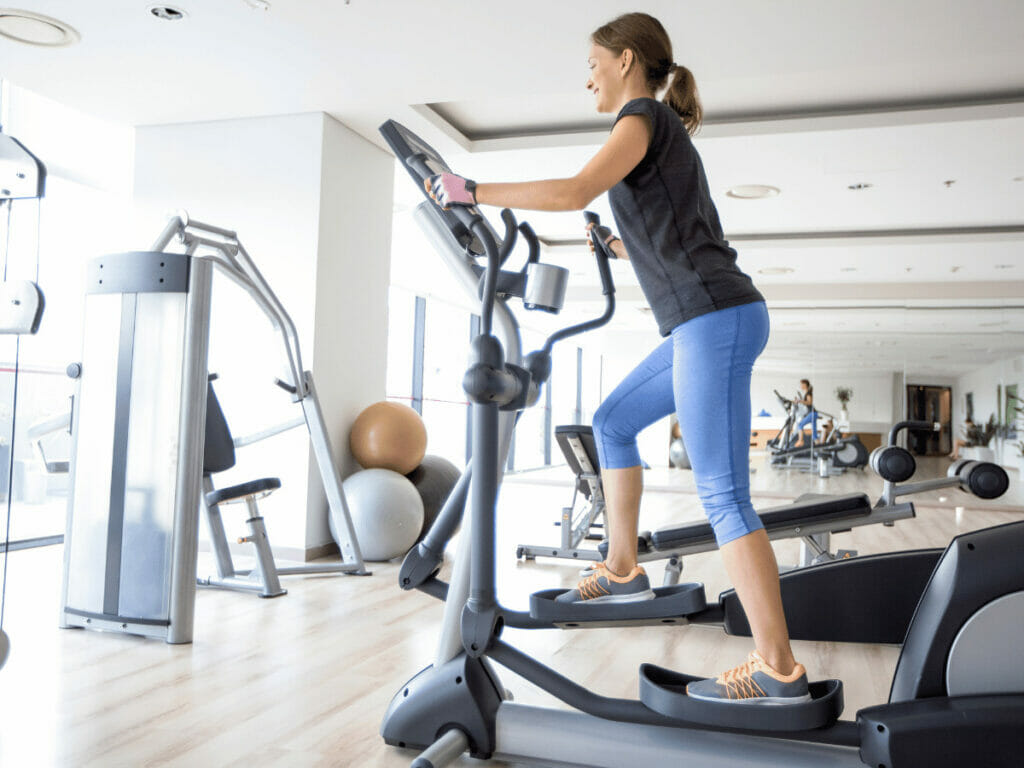
- What Areas/Muscles Does a Stair Climber Work: It primarily targets the lower body, engaging the glutes, quadriceps, hamstrings, and calves, and also works the core for stability.
- Stair Climber Cost: The cost of stair climbers can range from $1000 to $5000, based on models and features.
Advantages:
- Effective Cardiovascular Workout: Incorporating a stair climber into the gym provides an excellent cardiovascular workout. These machines simulate climbing stairs, which engage large muscle groups . Examples are glutes, quadriceps, and hamstrings, while also elevating heart rate and promoting cardiovascular endurance.
- Low Impact on Joints: Using a stair climber provides a low-impact workout that minimizes stress on the joints. The low-impact nature of these machines allows individuals to reap cardiovascular benefits while minimizing the risk of joint discomfort or exacerbating existing conditions.
Stepper Machine
A Stepper Machine is cardio fitness equipment that simulates the motion of climbing stairs. It typically consists of foot pedals that move up and down, providing a low-impact workout to improve cardiovascular health and lower body strength
- What Areas/Muscles Does a Stepper Machine Work: Stepper Machines primarily target the muscles of the lower body, including the quadriceps, hamstrings, glutes, and calves. The repetitive stepping motion also engages the core muscles for stabilization.
- Stepper Machine Cost: Steppers vary in price from $400 to $2500
Advantages:
- Lower Body Strength: Regular use of a Stepper Machine can strengthen and tone the muscles of the lower body, particularly the quadriceps, hamstrings, glutes, and calves.
- Low-Impact Exercise: Stepper Machines provide a low-impact workout, reducing stress on the joints, making them suitable for individuals with joint issues or those seeking a lower-impact cardio option.
Want to get our latest gym equipment catalog? We have pdf & excel versions available. Contact us directly at [email protected] for our current catalog right now.
2. Strength Training Equipment
In the ever-evolving realm of fitness, strength training holds a pivotal role. Not only does it contribute to physical aesthetics, but it also provides functional benefits, aiding in everyday tasks. This section will delve into some quintessential equipment for strength training.
Smith Machines
A Smith Machine is a piece of workout equipment that consists of a barbell fixed within steel rails, allowing vertical or near-vertical movements.
- What areas/muscles does a Smith Machine work: Primarily used for weight lifting, the Smith Machine targets a wide range of muscle groups, including quadriceps, hamstrings, glutes, and shoulders.
- Smith Machine cost: Smith Machines usually cost between $1000 to $3000.
Advantages:
- It provides stability during weight lifting, making it safer for beginners and solo gym-goers.
- This machine offers excellent body toning results, drawing many fitness enthusiasts.In practice, the smith machine has proven beneficial for many gyms, enhancing their appeal to serious bodybuilders and fitness enthusiasts alike.
Leg Extension
A Leg Extension machine, one of the types of leg machines is a resistance weight training device designed for isolating and strengthening the quadriceps muscles at the front of your upper leg. Users sit on the machine and extend their legs upward against the padded lever, providing controlled, targeted exercise.
- What Areas/Muscles Do Leg Extension Work: Leg Extensions primarily target the quadriceps muscles. This includes four separate muscles: the vastus lateralis, vastus medialis, vastus intermedius, and the rectus femoris, providing a comprehensive workout for the front of the upper leg.
- Leg Extension Cost: The cost of a leg extension machine can vary greatly based on its quality and brand, ranging anywhere from $500 for a basic, home-use model, up to $2500 for a high-end, commercial grade machine.
Advantages:
- Muscle Isolation: Leg Extensions are excellent for isolating the quadriceps, allowing for targeted strength training and development of these muscles.
- Injury Rehabilitation: This machine is often used in rehab programs for knee injuries as it can provide controlled, low-impact exercise for knee joint and surrounding muscles.
Cable Crossover
A Cable Crossover machine is a versatile piece of commercial strength equipment that features two high and two low pulleys positioned on opposite sides, allowing for a wide range of upper-body exercises. Users move the cables using various attachments to perform exercises that target specific muscle groups.
- What Areas/Muscles Do Cable Crossover Work: The Cable Crossover machine can target a wide array of muscles depending on the exercise performed. However, it’s especially effective at working the chest (pectoral muscles) and shoulders (deltoids) when performing traditional cable crossovers, as well as the arms (biceps and triceps) with different attachments and exercises.
- Cable Crossover Cost: Good-quality cable crossover machines are available for as low as $400, with the high-end ones costing up to $3000.
Advantages:
- Controlled Resistance: Cable machines offer consistent, controlled resistance, which can help in improving form, technique, and minimizing the risk of injury.
- Progressive Overload: The adjustable weights allow for easy customization of resistance levels, enabling users to incrementally increase the load for progressive overload, which is key for muscle growth and strength.
Shoulder Press Machine
The Shoulder Press Machine is a resistance training device specifically designed to strengthen the upper body, where users press weight directly upward from shoulder level. It provides a guided path for weights, ensuring controlled, isolated movement.
- What Areas/Muscles Do Shoulder Press Machine Work: The Shoulder Press primarily targets the deltoids in the shoulder, but it also engages the triceps in your upper arms and the trapezius muscles in your upper back during the pressing motion.
- Shoulder Press Machine Cost: Shoulder press machines nowadays may cost anywhere between $500 and $2500
Advantages:
- Muscle Isolation: A Shoulder Press Machine isolates the deltoid muscles, providing a targeted workout for this group and enhancing upper body strength.
- Suitability for Beginners: It’s perfect for gym newcomers as it requires less balance and coordination than free weight alternatives, while still offering significant strength-building benefits.
Flat Bench
A Flat Bench, one of the types of chest press machines, is a basic piece of gym equipment, usually consisting of a simple, sturdy, horizontal platform on legs, used in weight training and bodyweight exercises. It serves as a foundation for various workouts, supporting the body to ensure correct form and stability.
- What Areas/Muscles Do Flat Bench Work: Depending on the exercises performed, a Flat Bench can target a range of muscle groups. For instance, when used for bench press exercises, it primarily targets the pectoral muscles in the chest, triceps in the arms, and anterior deltoids in the shoulders.
- Flat Bench Cost: Flat benches range from $50 to $300
Advantages:
- Strength and Balance Training: When used with free weights, it can enhance core strength and improve balance and coordination, offering more comprehensive workouts.
- Space-Efficient: Due to its compact size, a Flat Bench doesn’t take up much space, making it an ideal choice for smaller gyms or home setups.
Roman Chair
A Roman chair is a specialized bench used for hyperextension exercises that train your lower back by bending your waist. Also called a hyperextension machine or hyper bench, it has padded shelves and ankle rests for support.
- What Areas/Muscles Do Roman Chair Works: The Roman Chair primarily targets the erector spinae muscles in the lower back. However, exercises performed on it can also engage the glutes, hamstrings, and even the abdominals, depending on the variation of the exercise.
- Roman Chair Cost: A Roman chair can cost as low as $80, and as high as $1000.
Advantages:
- Lower Back Strength: The Roman Chair provides an effective way to strengthen the muscles of the lower back, which can help improve posture, stability, and reduce the risk of lower back injuries.
- Core Stability: By engaging the core muscles, particularly the abdominals and obliques, during exercises, the Roman Chair helps develop core strength and stability, leading to improved overall strength and balance.
Power Rack
A Power Rack, also known as a squat rack or power cage, or one of the various squat machine types, is a versatile piece of gym equipment that features vertical posts with adjustable safety bars and hooks, designed to support and secure barbells during various strength training exercises like squats, bench presses, and overhead presses.
- What Areas/Muscles Do Power Rack Works: The Power Rack allows for a wide range of exercises that target multiple muscle groups. It primarily works the major muscles of the lower body, including the quadriceps, hamstrings, glutes, and calves, as well as the upper body muscles such as the chest, shoulders, back, and arms, depending on the exercises performed.
- Power Rack Cost: You may find a power rack priced anywhere between $300 and $3000.
Advantages:
- Progressive Overload: With the ability to easily adjust the weights and safety bars, a Power Rack facilitates progressive overload, a key principle for muscle strength and growth.
- Full-Body Workout: The Power Rack enables a wide range of exercises that target multiple muscle groups, providing a comprehensive and efficient full-body workout, making it a valuable piece of equipment for strength training.
Weight Machines
Weight machines, including types of lat pulldown machines, are designed to target specific muscle groups, often using a system of cables, pulleys, and weight stacks.
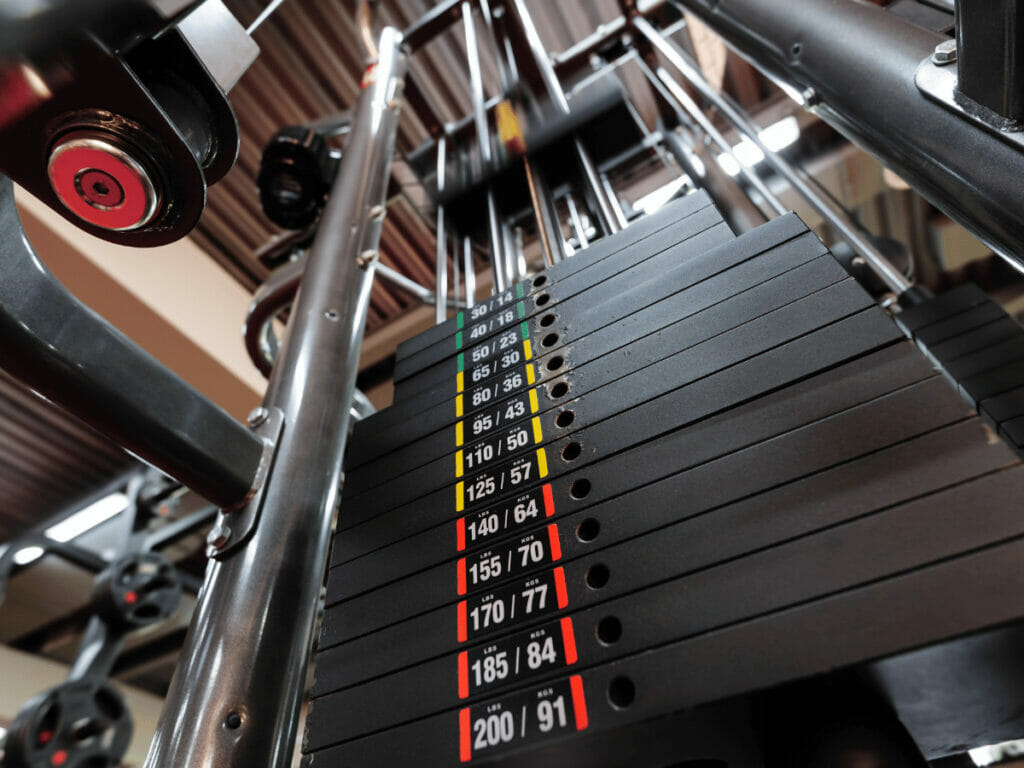
- What Areas/Muscles Do Weight Machines Work: The muscles targeted by weight machines depend on the machine. They can focus on the upper body, lower body, or specific muscles depending on the type of machine.
- Weight Machines Cost: The cost of weight machines can range widely based on the type and brand, typically ranging from $500 to $5,000.
Advantages:
- Beginner-friendly: Weight machines are easier to use for beginners and offer a safer way to lift weights, especially for those still learning proper form.
- Isolated workouts: They allow for targeted muscle workouts, beneficial for rehabilitation or specific training needs.
Pull-Up Bars
A pull-up bar is a gym equipment piece that enables upper body exercises like pull-ups and chin-ups.
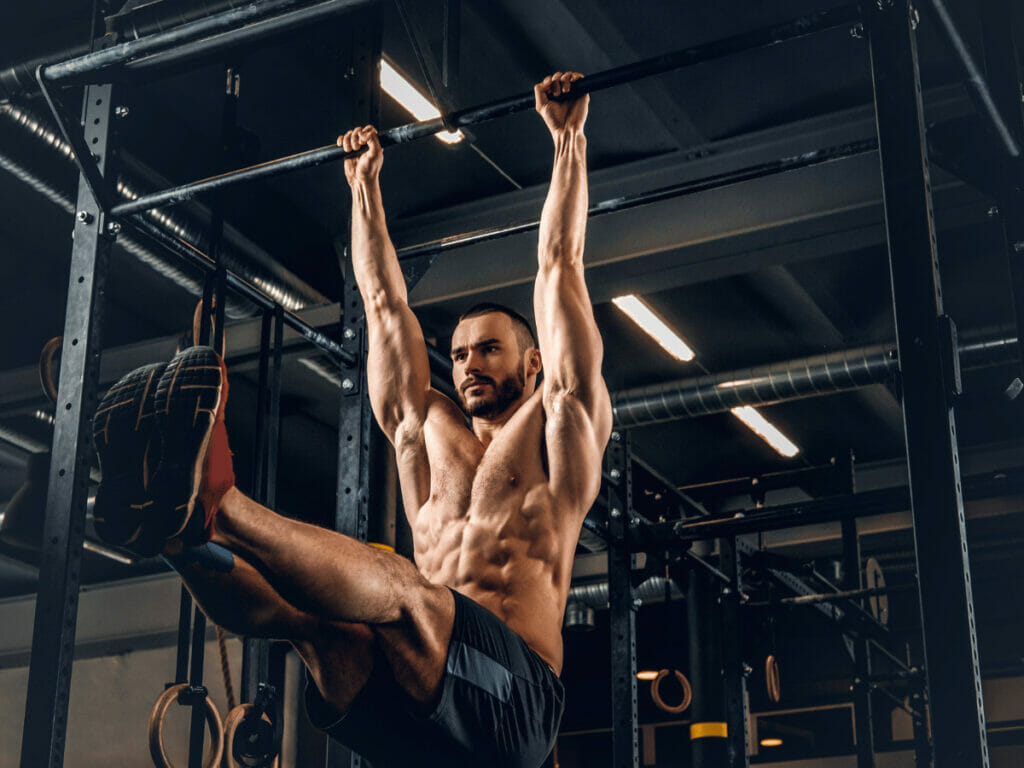
- What Areas/Muscles Do Pull-Up Bars Work: Pull-up bars primarily target the upper body, working muscles like the latissimus dorsi, biceps, and forearms.
- Pull-Up Bars Cost: Pull-up bars typically range from $20 to $500, depending on the type and installation complexity.
Advantages:
- Upper Body Strength: Pull-up bars significantly aid in building upper body strength.
- Low Maintenance: Pull-up bars require minimal maintenance, which is beneficial for a gym setting.
Weight Benches
A weight bench is a padded bench used for weight lifting and strength training exercises.
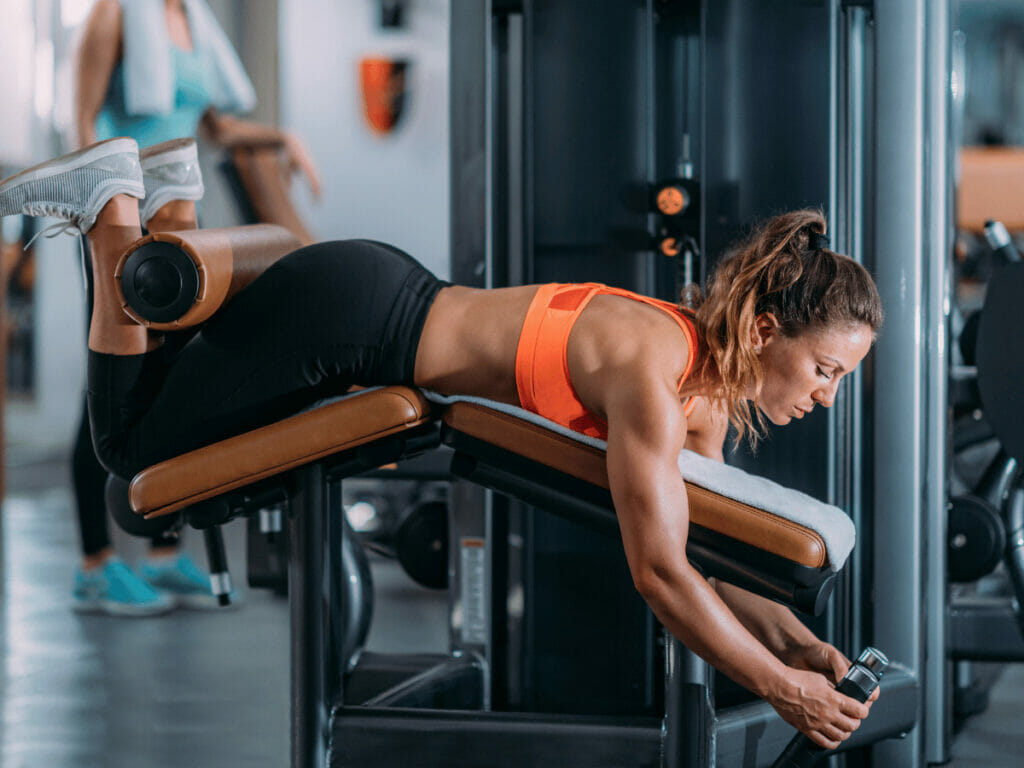
- What Areas/Muscles Do Weight Benches Work: A weight bench can be used for exercises that target a wide array of muscles, including the chest, arms, back, and legs.
- Weight Benches Cost: Weight benches typically cost between $100 and $800, based on the design and features.
Advantages:
- Safety: They provide a stable platform for performing heavy lifting, enhancing safety.
- Adjustability: Many weight benches can be adjusted for different exercises and positions, allowing for a more comprehensive workout. Based on my experience, the versatility of the adjustability feature keeps my workout routines dynamic and engaging, promoting consistent progress.
Want to get our latest gym equipment catalog? We have pdf & excel versions available. Contact us directly at [email protected] for our current catalog right now.
3. Gym Accessories
Gym accessories refer to a wide range of items and equipment that are used to enhance workouts and provide support during exercise. They are designed to improve comfort, safety, and effectiveness during gym sessions. These accessories include items such as:
Free Weights (Dumbbells and Barbells)
Free weights, encompassing both dumbbells and barbells, are fundamental pieces of gym equipment. They are available in various weights and are used to perform an array of exercises.
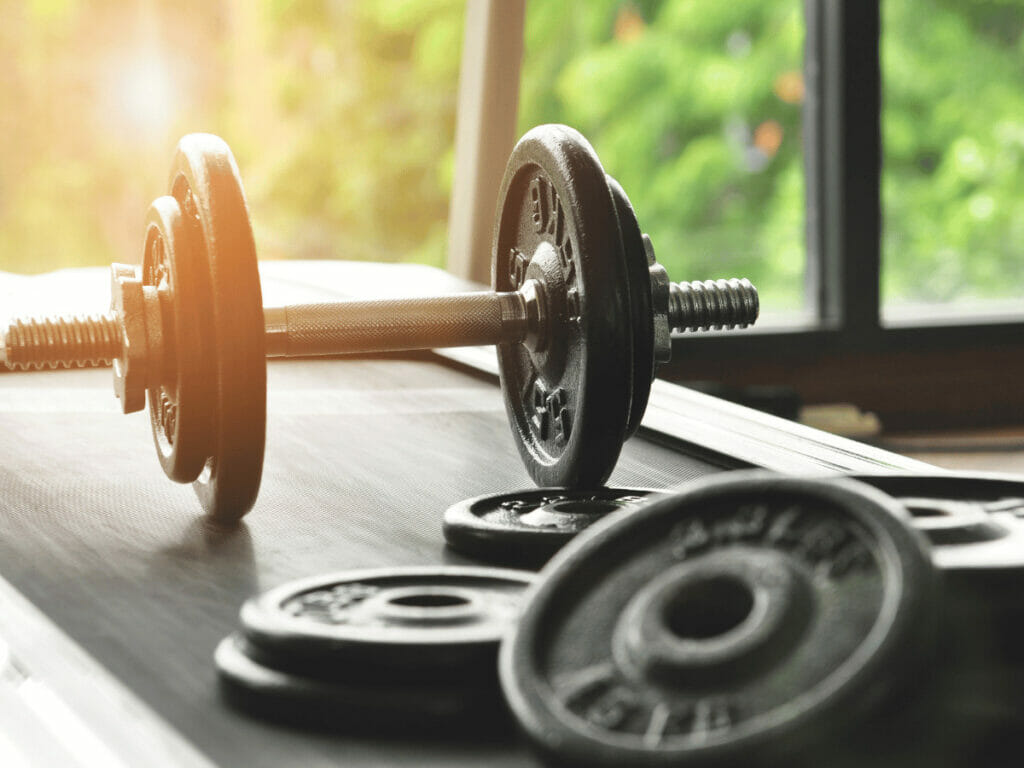
- What Areas/Muscles Do Free Weights Work: Free weights provide a comprehensive workout targeting multiple muscle groups. Depending on the exercises chosen, they can work the upper body, lower body, and core muscles.
- Free Weights Cost: The price range for free weights can vary, with dumbbells and barbells typically costing anywhere between $1 to $3 per pound.
Advantages:
- Functionality: They enhance functional fitness, strengthening the body for daily tasks.
- Promotion of stability: As they require the body to stabilize during use, free weights help improve balance and coordination.
Kettlebells
A kettlebell is a ball-shaped weight with a handle on top. It’s a versatile piece of equipment used for strength, flexibility, and balance training.
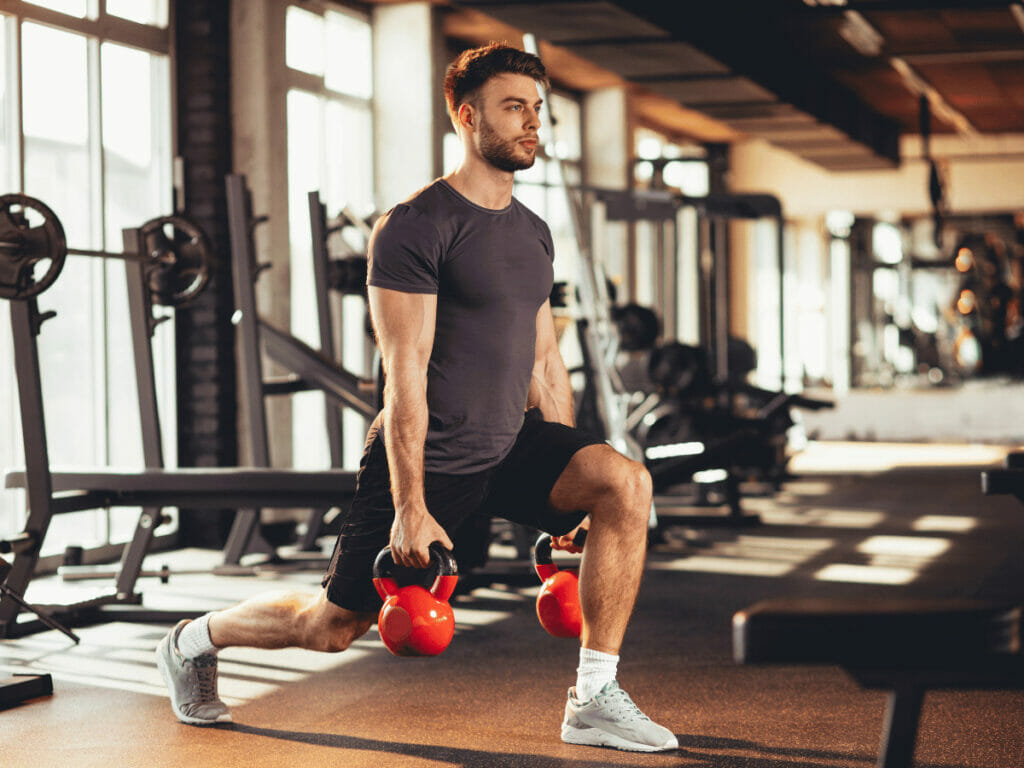
- What Areas/Muscles Do Kettlebells Work: Kettlebells offer a full-body workout, engaging everything from the legs and glutes to the back, chest, and arms(1).
- Kettlebells Cost: Kettlebells can range from $10 to $200 depending on the weight and brand.
Advantages:
- Full-body workouts: Kettlebells are known for their ability to provide comprehensive workouts, engaging multiple muscle groups.
- Space-efficient: Their compact design makes them a space-efficient choice for any gym.
Weight Plate
A Weight Plate is a flat, circular disk made of metal or rubber that is loaded onto a barbell or used independently for resistance training. It provides adjustable weight increments for various exercises, such as squats, deadlifts, bench presses, and more.
- What Areas/Muscles Do Weight Plate Work: Weight plates are versatile and can be used to target a wide range of muscles depending on the exercise. They primarily engage muscles in the lower body, such as the quadriceps, hamstrings, glutes, and calves, as well as muscles in the upper body, including the chest, shoulders, back, and arms.
- Weight Plate Cost: Depending on their weight and quality, the cost can vary from $10 to $300
Advantages:
- Progressive Overload: Weight plates allow for progressive overload, meaning you can gradually increase the resistance to continually challenge and strengthen your muscles over time.
- Customizable Workouts: With weight plates, you have the flexibility to adjust the load according to your fitness level and specific training goals, enabling personalized and tailored workouts.
Resistance Band
A Resistance Band is a simple yet versatile piece of fitness equipment made of strong, thin rubber with handles at the end, used to perform a variety of strength training exercises. It provides resistance when stretched, helping to strengthen and tone a wide range of muscles.
- What areas/muscles does a Resistance Band work: Depending on the exercises performed, resistance bands can work almost every major muscle group in the body. This includes muscles in the arms (biceps and triceps), legs (quadriceps, hamstrings, calves), back (latissimus dorsi), chest (pectorals), and core (abs and obliques).
- Resistance Band Cost: Resistance band prices range from $10 to $80
Advantages:
- Space Efficiency: Due to their compact nature, resistance bands take up very little space, making them an ideal choice for any gym, regardless of size.
- Suitable for All Fitness Levels: They come in various resistance levels, from light to heavy, making them suitable for gym-goers of all fitness levels and allowing progression as strength improves.
Aerobic Stepper
An Aerobic Stepper is a fitness platform with adjustable height levels used for aerobic exercises, such as step-ups, step aerobics, and various cardio workouts. It provides a versatile and dynamic way to engage the lower body muscles and elevate heart rate.
- What areas/muscles does an Aerobic Stepper work: The Aerobic Stepper primarily targets the muscles of the lower body, including the quadriceps, hamstrings, glutes, and calves. It also engages the core muscles for stability and balance during exercises.
- Aerobic Stepper Cost: Aerobic step prices range from $20 to $100
Advantages:
- Cardiovascular Fitness: Aerobic steppers provide a cardio workout that elevates heart rate, improves endurance, and contributes to overall cardiovascular fitness.
- Lower Body Strength and Toning: Regular use of an aerobic stepper helps strengthen and tone the muscles of the lower body, including the quadriceps, hamstrings, glutes, and calves, leading to improved strength and definition.
Foam Rollers
A foam roller is a cylindrical piece of equipment used for self-myofascial release, a technique that helps soothe tight, stressed muscles .
- What areas/muscles does a Foam Roller Work: Foam rollers can be used on various body parts, including the back, legs, and arms, to alleviate muscle tightness and aid in recovery . They essentially aid in massaging the muscles and fascia (connective tissue).
- Foam Roller cost: Foam rollers are generally priced between $10 and $60.
Advantages:
- Promotes muscle recovery: Foam rollers help reduce muscle soreness and speed up recovery after a workout.
- Increases mobility and flexibility: Regular use can lead to increased joint range of motion and overall flexibility. The feedback on foam rollers in my gym has been overwhelmingly positive, with members appreciating the ability to perform their own muscle recovery techniques.
- Cost-effective: Compared to professional massage treatments, foam rollers offer a budget-friendly option for myofascial release.
Medicine Balls
A Medicine Ball is a heavy ball utilized in various strength training exercises. The weight of the ball can vary, making it a versatile piece of equipment for various fitness levels.
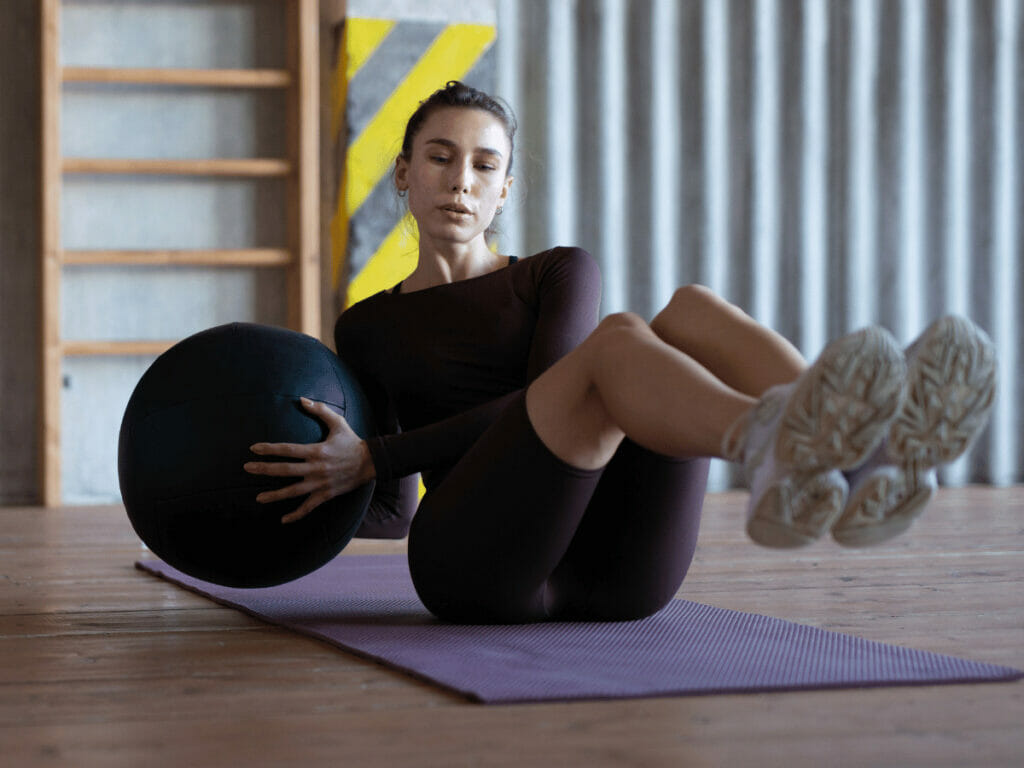
- What Areas/Muscles Do Medicine Balls Work: Medicine balls are often used in compound movements, allowing for work on multiple muscles simultaneously. Major muscle groups engaged include core muscles, as well as upper and lower body muscles depending on the exercise.
- Medicine Balls Cost: Typically, the price range for medicine balls falls between $20 and $100, depending on the weight and brand.
Advantages:
- Engages multiple muscle groups: Their use in compound movements allows for a comprehensive workout, targeting multiple muscle groups.
- Suits various fitness levels: The varying weights of medicine balls make them suitable for different fitness levels. Personally, I’ve found that this adaptability is a great advantage, allowing me to gradually increase the challenge as my strength improves, thus offering a tailored workout experience.
Wall Ball
A Wall Ball is a piece of fitness equipment, essentially a weighted ball, often used in high-intensity workouts for throwing against a wall or performing squats. The weight, size, and bouncy material of the ball offers resistance and can increase the challenge of various exercises.
- What Areas/Muscles Do Wall Balls Work: Wall Ball exercises engage a variety of muscles, with the most common movements like wall ball shots targeting the lower body (quadriceps, glutes, and hamstrings), core (abdominals and lower back), and upper body (shoulders, chest, and arms).
- Wall Ball Cost: Average quality wall balls may cost $10 to $80, while good quality ones range from $150 to $300
Advantages:
- Scalability: Available in a variety of weights, they cater to a broad range of fitness levels, allowing individuals to scale their workouts as they grow stronger.
- Space-Efficient: Given their compact size, wall balls don’t take up much space and can be easily stored, making them an excellent choice for any gym, regardless of its size.
Gymnastic Ring
Gymnastic Rings are a pair of suspended rings used in gymnastics and bodyweight training. They engage multiple muscle groups, including the upper body, core, and stabilizer muscles, providing a challenging and dynamic workout.
- What Areas/Muscles Do Gymnastic Rings Works: Gymnastic Rings primarily target the upper body muscles, including the chest (pectoral muscles), shoulders (deltoids), back (latissimus dorsi), arms (biceps and triceps), and core muscles. They also engage stabilizer muscles throughout the body for balance and control.
- Gymnastic Ring Cost: Expect to pay between $30 and $80 for a pair of gymnastic rings.
Advantages:
- Full-Body Strength and Stability: Gymnastic rings provide a challenging workout that engages multiple muscle groups, promoting overall strength, stability, and coordination.
- Versatility and Progression: Gymnastic rings offer a wide range of exercises, suitable for beginners to advanced users. They can be adjusted to different heights and angles, allowing for progressive training and accommodating various fitness levels and goals.
Yoga Mats
A yoga mat is a simple but essential tool used in a wide variety of fitness activities, including, of course, yoga. It provides a comfortable, non-slip surface to perform exercises on, protecting users from the hard floor underneath.
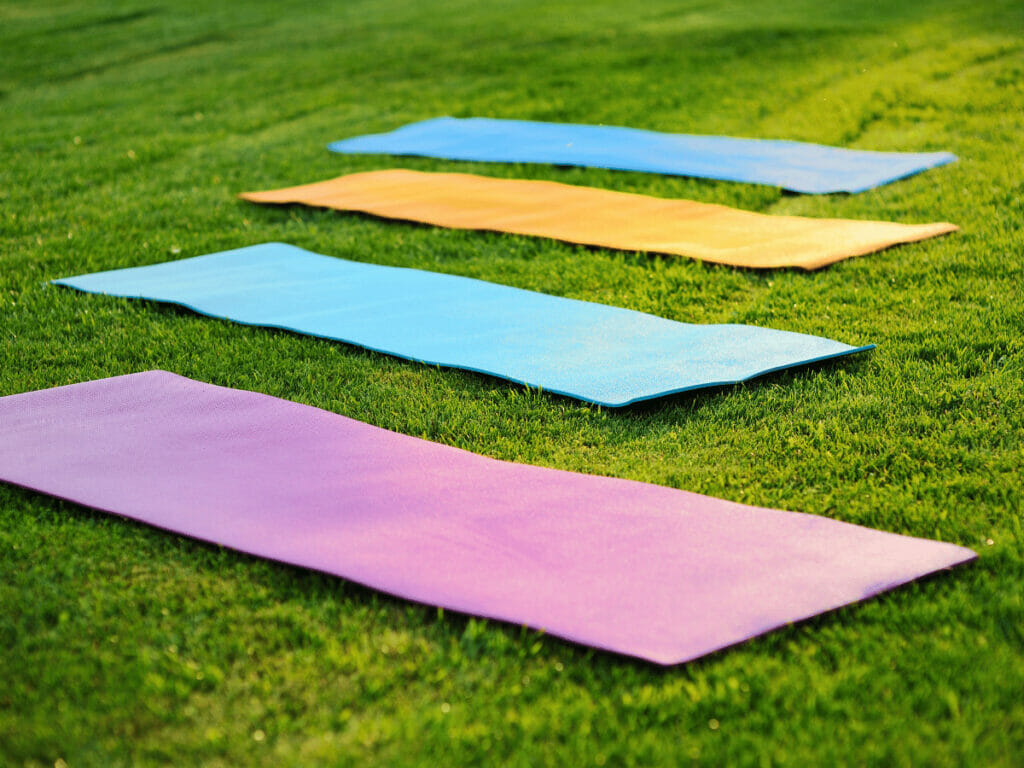
- What areas/muscles does a Yoga Mat work: A yoga mat doesn’t target specific muscles; instead, it facilitates exercises that can work on any muscle group. It’s an accessory that aids in performing yoga poses, pilates, stretching, and other bodyweight exercises more comfortably.
- Yoga Mat cost: The cost of yoga mats typically falls between $15 and $100, depending on the quality and brand.
Advantages:
- Comfort and safety: Yoga mats provide a cushioned surface that protects joints and offers a safe, non-slip environment for exercises. As a gym owner, I’ve found that investing in high-quality yoga mats greatly enhances the members’ overall workout experience and, therefore, their satisfaction.
- Versatility: They’re not only useful for yoga but also other exercises like pilates, stretching, and bodyweight exercises.
Agility Ladder
An Agility Ladder is a training tool consisting of a ladder-shaped structure with evenly spaced rungs. It is used to improve footwork, coordination, speed, and agility by performing various drills and exercises.
- What areas/muscles does a Agility Ladder work: The Agility Ladder primarily focuses on improving agility, quickness, and coordination. While it doesn’t directly target specific muscles, it engages the lower body muscles, including the quadriceps, hamstrings, calves, and glutes, as well as the core muscles for stability and balance.
- Agility Ladder Cost: On average, an agility ladder can cost from $10 to $30.
Advantages:
- Improved Speed and Agility: Agility ladder drills enhance footwork, coordination, speed, and agility, benefiting athletes in various sports and activities that require quick and precise movements.
- Enhanced Balance and Coordination: Regular practice with the agility ladder improves balance, coordination, and proprioception, contributing to better overall body control and movement efficiency.
Stability Balls
A Stability Ball, also known as an exercise or Swiss ball, is a large, inflatable ball used for strength and balance exercises. According to a study in Greatist , stability balls are also great for getting back into shape after an injury because they can reduce muscle and spinal strain for certain movements.
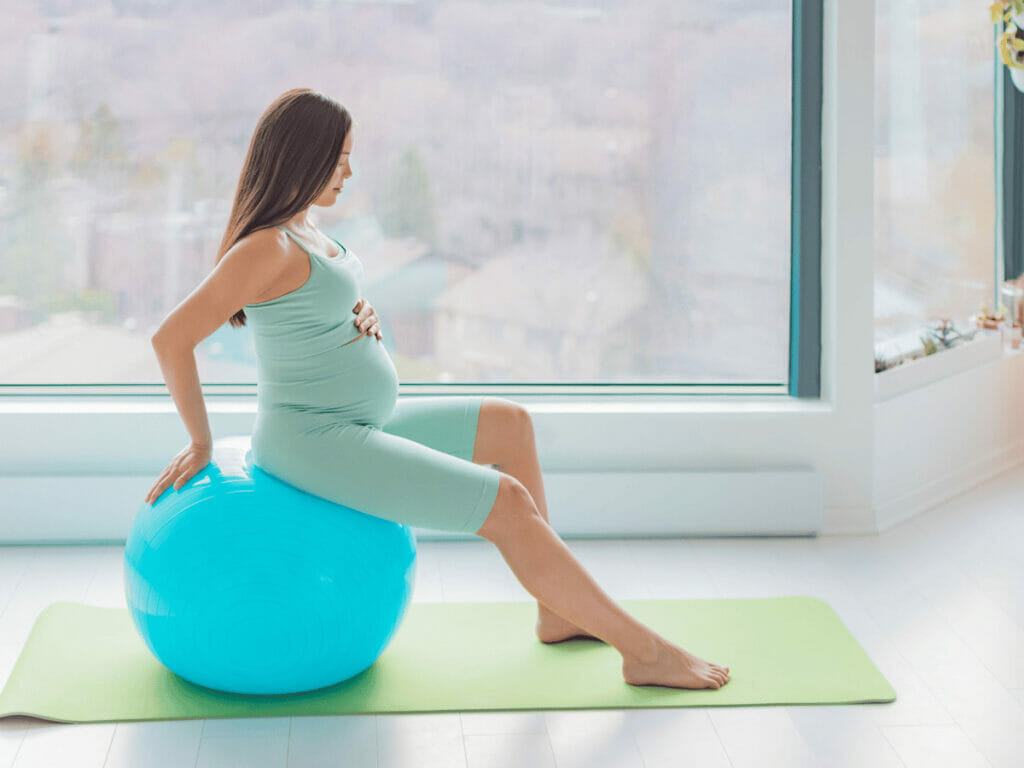
- What Areas/Muscles Do Stability Balls Work: Stability balls primarily engage the core muscles but can also target the back, arms, chest, and lower body muscles when incorporated into different exercises.
- How Much Do Stability Balls Cost: The cost of stability balls generally ranges between $10 and $50.
Advantages:
- Strengthens core muscles: Stability balls challenge the muscles in core, including the abs, hips, and lower back, enhancing overall stability and balance. With regular use, the stability ball will significantly improve core strength and stability.
- Improves flexibility: The dynamic nature of the stability ball allows for a broader range of motion, which can help to maintain loose and limber joints, ultimately preventing injuries and improving overall athletic performance.
Plyo Box
A Plyo Box, short for plyometric box, is a sturdy platform of various heights used in fitness training for jumping exercises to increase speed, power, and explosiveness. These boxes are a staple in plyometric training, a type of exercise that focuses on quick, powerful movements.
- What Areas/Muscles Do Plyo Box Work: Plyo Box exercises primarily target the lower body muscles, including the quadriceps, hamstrings, glutes, and calf muscles. However, with the right exercises, they can also engage the core and upper body.
- Plyo Box Cost: Plyo box prices vary depending on whether you purchase a set or a single box, and also on their height and size. A minimum price of $50 is typical for a plyo box, with the largest and best quality ones costing up to $300
Advantages:
- Improved Athletic Performance: Plyometric training with a Plyo Box can enhance power, speed, and agility, benefiting athletes in many sports.
- Progressive Training: Available at various heights, Plyo Boxes cater to different fitness levels, allowing for progression as strength, power, and confidence improve.
Jump Rope
A jump rope is a tool used in a form of cardiovascular exercise where an individual jumps over a swinging rope.
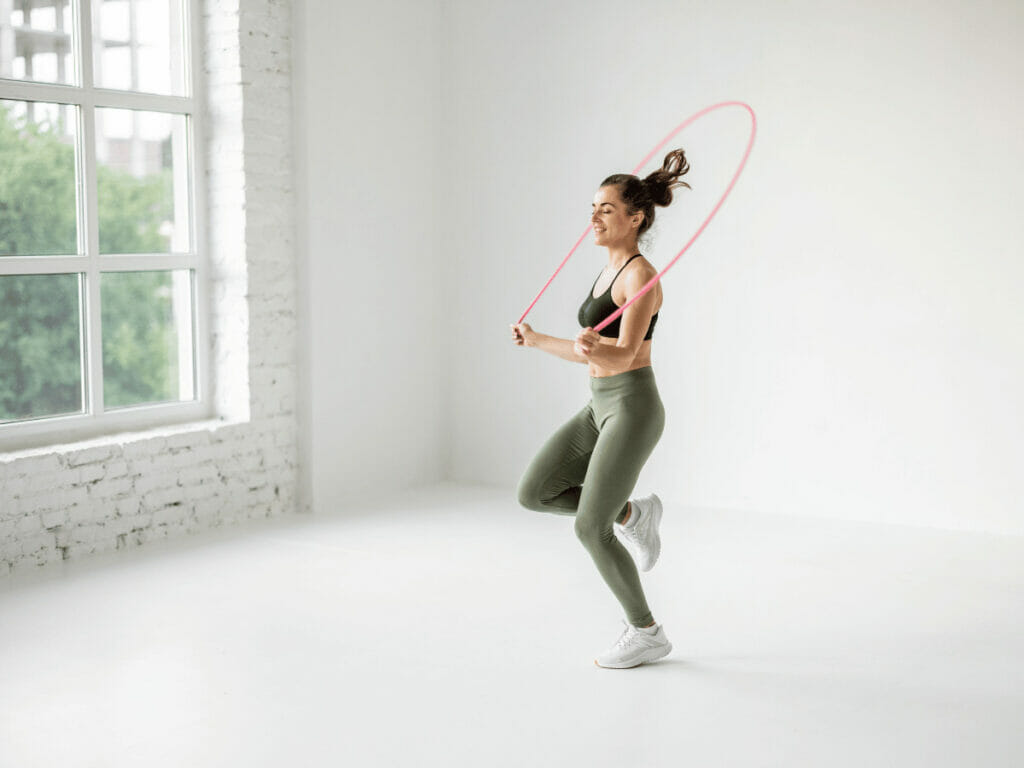
- What Areas/Muscles Does a Jump Rope Work: Jumping rope primarily works the calves and thighs but also engages the arms, shoulders, and core, offering a full-body workout.
- Jump Rope Cost: The price for a standard jump rope can range from $10 to $50, making it an affordable addition to any gym.
Advantages:
- Versatility: Jump ropes can be used for different workout styles, from high-intensity interval training (HIIT) to endurance training.
- Low-Cost: It’s a cost-effective investment for any gym, given its broad range of uses and benefits. Jump ropes, due to their cost-effectiveness and versatility, are a must-have for every gym setup.
Suspension Trainers (TRX)
A Suspension Trainer, such as the TRX system, is a pair of straps that provides gravity-based resistance training.
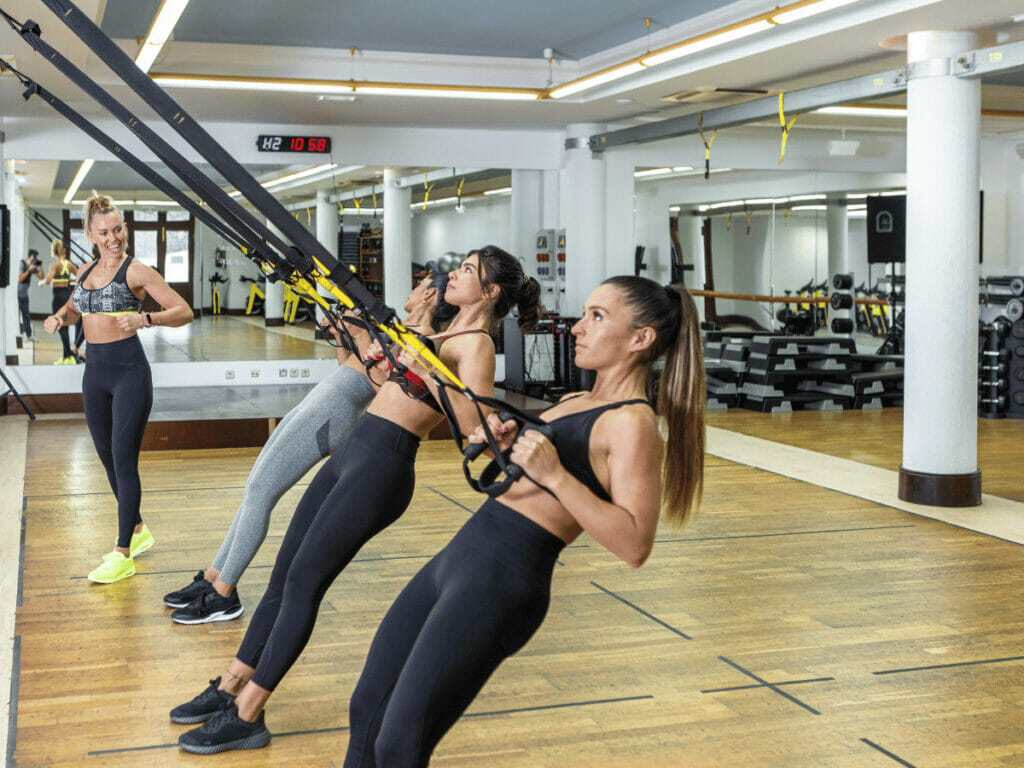
- What Areas/Muscles Do Suspension Trainers Work: Suspension trainers provide a full-body workout, targeting muscles in the arms, legs, and particularly the core.
- Suspension Trainers Cost: The price for suspension trainers can range from $50 to $200, depending on the brand and model.
Advantages:
- Full-Body workout: Suspension trainers offer a comprehensive workout, engaging the entire body.
- Promotes balance and stability: Regular training with suspension trainers can enhance balance and stability.
Battle Ropes
Battle Ropes are thick, heavy ropes used for high-intensity interval training, promoting strength and endurance
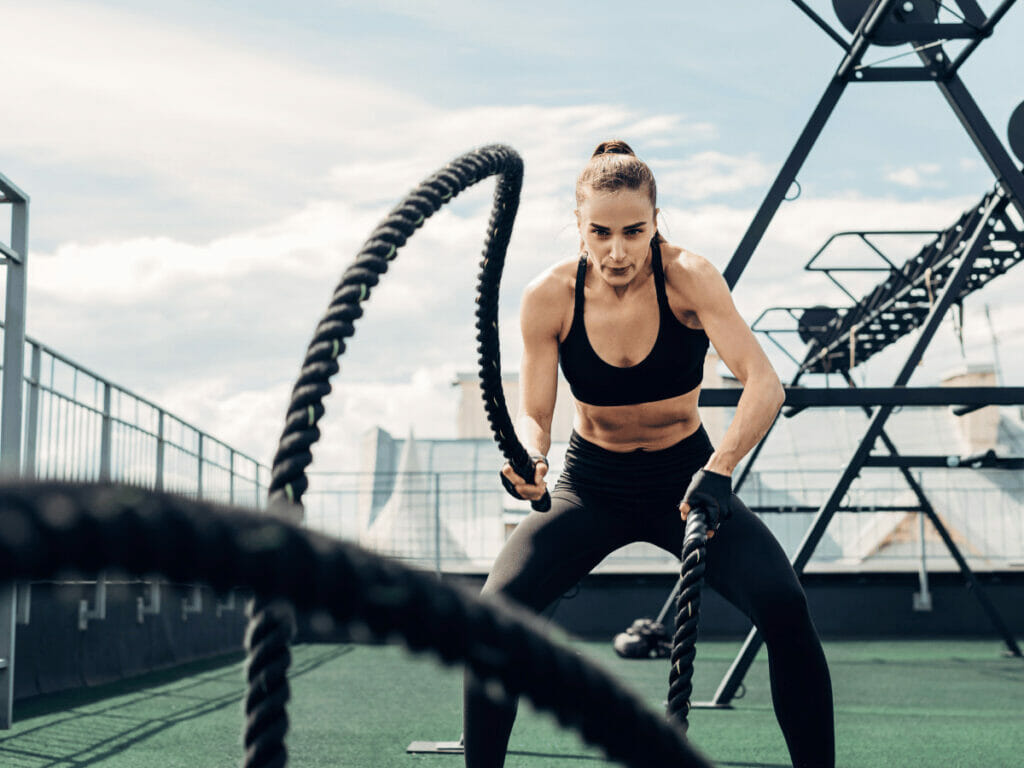
- What Areas/Muscles Do Battle Ropes Work: Battle ropes target a wide range of muscles, including the arms, back, chest, legs, and core.
- Battle Ropes Cost: Typically, battle ropes cost between $50 and $200, depending on the length and diameter.
Advantages:
- High-intensity workout: Battle ropes offer high-intensity exercises, which are ideal for cardiovascular and strength training.
- Improves coordination: Regular use can enhance bilateral coordination. As a fitness professional, battle ropes are my go-to for a challenging, heart-pumping session. The intensity and diversity of exercises it offers never fails to bring about progress among gym members.
Want to get our latest gym equipment catalog? We have pdf & excel versions available. Contact us directly at [email protected] for our current catalog right now.
4. Advanced and Specialty Gym Equipment
The evolution of fitness necessitates gyms to continually expand their equipment range, shifting from the basic equipment to include advanced and specialty tools. Such equipment aids in offering gym-goers diverse workout routines, targeting specific muscle groups and providing a complete body workout.
Let’s delve into different advanced and specialty gym equipment:
Hex Bar/Trap Bar
A Hex Bar, also known as a Trap Bar, is a hexagonal-shaped barbell used for deadlifts, squats, and other weight lifting exercises.
What areas/muscles does a Hex Bar/Trap Bar work: The Hex Bar targets the lower body muscles, such as the hamstrings, quadriceps, glutes, and calves, while also engaging the upper body.
Hex Bar/Trap Bar cost: Hex Bars usually range from $100 to $300.
Advantages:
- The unique design offers a better grip, reducing the risk of injuries and allowing for heavier lifts.
- This equipment provides a full-body workout, ensuring comprehensive fitness.
- It is effective in building strength, making it a preferred tool for powerlifters and athletes.
Glute Ham Developer (GHD)
A Glute Ham Developer (GHD) is a specialized machine designed for strengthening the glutes, hamstrings, lower back, and abdominals.
- What areas/muscles does a Glute Ham Developer work: As its name suggests, the GHD primarily works the glutes and hamstrings. However, it also targets the lower back, calves, and abdominals.
- Glute Ham Developer cost: A Glute Ham Developer can cost between $200 to $1000.
Advantages:
- The GHD is effective in enhancing posterior chain strength, improving overall athletic performance.
- This machine offers versatility with various exercise options, enhancing user engagement.I vouch that GHD has become a gym staple, contributing to members’ progress in strength and functional training.
- It promotes better posture and aids in injury prevention, vital for long-term fitness.
Specialty Cardio Equipment (Spin bikes, Air bikes)
Specialty Cardio Equipment refers to advanced cardio machines like Spin Bikes and Air Bikes, which offer more engaging and efficient cardiovascular workouts.
What areas/muscles does Specialty Cardio Equipment work: These machines target large muscle groups in the body, providing a comprehensive cardio workout that enhances cardiovascular health, endurance, and calorie burn.
Specialty cardio equipment cost: The price of Specialty Cardio Equipment ranges from $500 to $2000, depending on the specific type and brand.
Advantages:
- Specialty Cardio Equipment, like Spin Bikes, can make cardio workouts more enjoyable, increasing gym engagement rates.
- These machines offer high-intensity workouts, leading to faster calorie burn and improved fitness levels.
- They are suitable for all fitness levels, making them a valuable addition to any gym.
The table below highlights the advantages of incorporating Specialty Cardio Equipment, such as Spin Bikes and Air Bikes, into a gym setting.
| Advantage | Description |
| Increased Gym Engagement Rates | Specialty Cardio Equipment, such as Spin Bikes, can make cardio workouts more enjoyable, attracting and retaining members. |
| Faster Calorie Burn | These machines provide high-intensity workouts, resulting in increased calorie burn and accelerated weight loss. |
| Improved Fitness Levels | Regular use of Specialty Cardio Equipment can lead to improved cardiovascular endurance and overall fitness levels. |
| Suitable for All Fitness Levels | Spin bikes and air bikes are adjustable, allowing individuals of all fitness levels to use them effectively and safely. |
| Versatile Workout Options | Specialty Cardio Equipment offers various workout options, including interval training, hill climbs, and endurance rides. |
| Low-Impact Exercise | Spin bikes and air bikes provide low-impact workouts, minimizing stress on joints while still delivering an intense workout. |
| Trackable Metrics and Progress Monitoring | Many Specialty Cardio Equipment have built-in monitors to track metrics such as distance, speed, calories burned, and more. |
| Time-Efficient Workouts | High-intensity workouts on Spin Bikes and Air Bikes can deliver efficient results in a shorter amount of time. |
| Cardiovascular Health Benefits | Regular cardio workouts on these machines can improve heart health, lower blood pressure, and reduce the risk of diseases. |
Want to get our latest gym equipment catalog? We have pdf & excel versions available. Contact us directly at [email protected] for our current catalog right now.
5. Conclusion
We trust this in-depth guide has equipped you with the essential insights needed to develop a holistic and gratifying workout routine in your gym. As a fitness aficionado, I am a firm believer that the journey towards a healthier lifestyle commences with having the right strength equipment manufacturer at your disposal and a keen understanding of its potential benefits.
Should you have any queries regarding the products highlighted or if you require further detailed information, please do not hesitate to reach out. Additionally, if you’d like a copy of our all gym equipment names with photos pdf, we’d be happy to provide it. We stand at the ready to assist, and we are excited at the prospect of being part of your fitness narrative.
Related articles:

